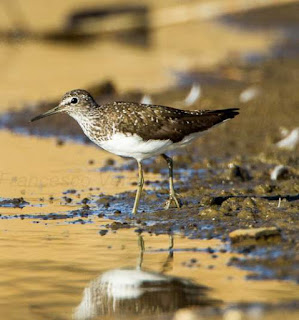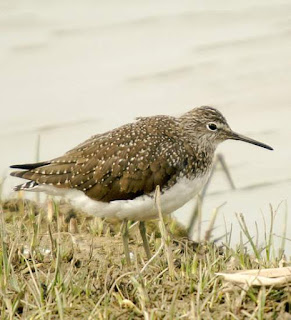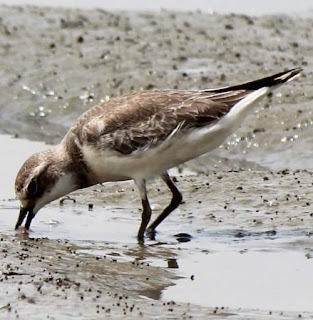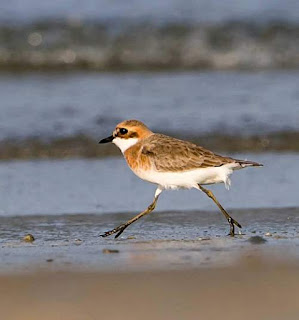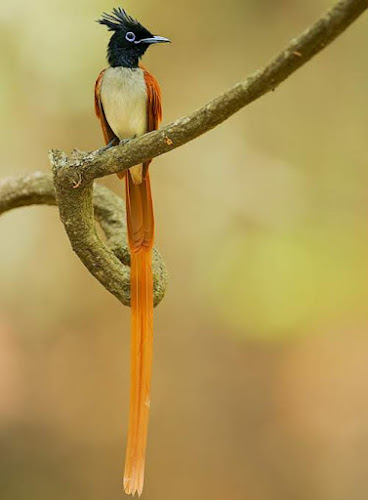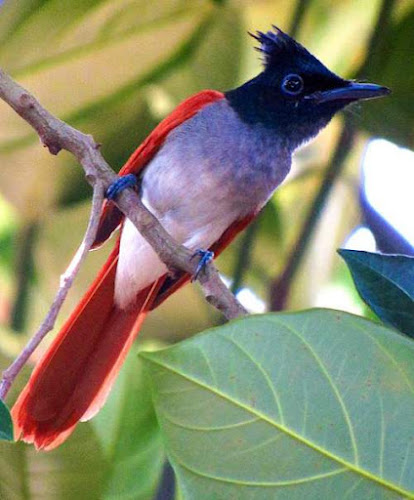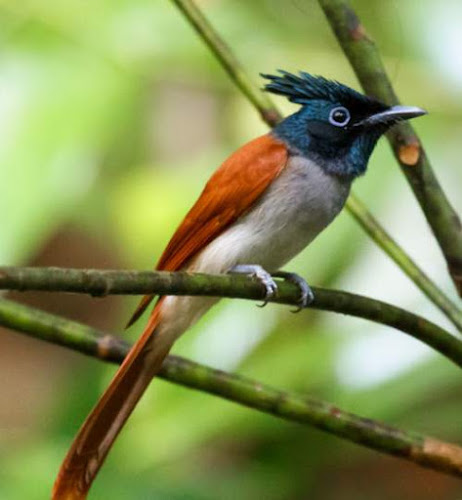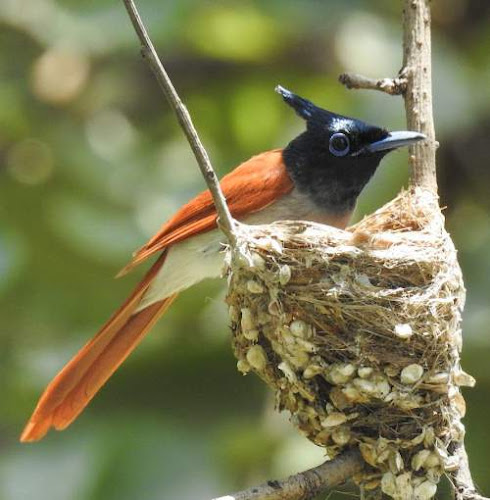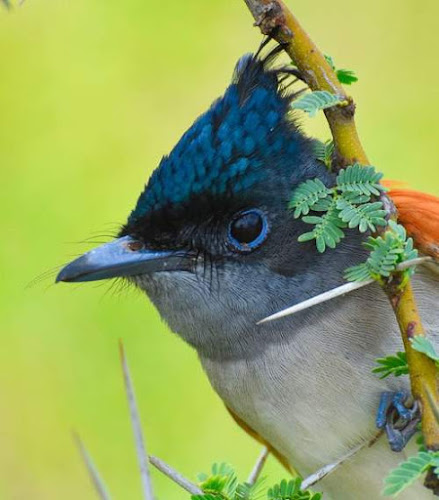Indian birds ›
Indian paradise flycatcher images ›
Lesser sand-plover - Charadrius mongolus
The lesser sand plover (
Charadrius mongolus) belongs to the family of lapwings and plovers, the Charadriidae.
The lesser sand plover species is distributed in Africa, Arabian peninsula, Indian subcontinent, southeast Asia, Australia, China and northeast Russia. These plover species are fully migratory. These plovers are polytypic species.
Appearance, physical description and identification
The lesser sand plover (
Charadrius mongolus) is a small to medium-sized plover, measuring 17 to 22 cm in length and weighing 40 to 110 grams. The wingspan is 45 to 60 cm.
The breeding male lesser sand plover has gray-brown crown, nape and upperparts. The sides of the neck and hindneck are chestnut. A broad black mask extends from the base of the bill to ear coverts, passing through the eyes.
There is a dark brown stripe above the forehead. The underparts are white. The female lesser sand plover has dark grey-brown or rufous mask. There is no dark stripe on the forehead. In non breeding plumage, the black and chestnut marks become gray-brown.
The bill is black. The irises are dark brown. There is a white eye-ring. The legs are dark gray. The call of these lesser sand plover species is a short, hard "drrrit" or a hard trilling sound.
 |
| 1.Birds of India - Image of Lesser sand-plover - Charadrius mongolus by JJ Harrison |
 |
| 2.Indian birds - Image of Lesser sand-plover - Charadrius mongolus by JJ Harrison |
 |
| 3.Birds of India - Image of Lesser sand-plover - Charadrius mongolus by Alpsdake |
Origin, geographical range and distribution
These lesser sand plover species are distributed in eastern coastal Africa, south coastal Arabia, coastal Indian subcontinent, coastal southeast Asia, coastal Australia, Himalayan region, central Asia, central and western China and eastern Russia.
The lesser sand plover nominate subspecies
C. m. mongolus is distributed in far east Russia and winters in Taiwan and Australia. The subspecies
C. m. schaeferi is distributed in south Mongolia and central China. It winters in Thailand and Indonesia.
The lesser sand plover subspecies
C. m. atrifrons breeds in Himalayas and southern Tibetan Plateau and winters in India and Indonesia (Sumatra). The lesser sand plover subspecies
C. m. pamirensis breeds in central Asia and winters in Africa and western India.
The plover subspecies
C. m. stegmanni is distributed in northeast Siberia and winters in Taiwan, Philippines, Papua New Guinea and surrounding islands and Australia.
The Important Bird and Biodiversity Areas (IBA) of these lesser sand plover species in Australia are Great Sandy Strait and Gulf Plains. The IBA in China are Laizhou Wan, Yalu Jiang Estuary and Ulungur Hu and Jili Hu.
The IBA of these lesser sand plovers in India are Mahul - Sewri Creek and Kaliveli Tank and Yeduyanthittu estuary. The IBA in Russia are Aniva bay, Tyk and Viakhtu bays, Nevskoye Lake, Ola lagoon and North-east Sakhalin lagoons.
The IBA of these plovers in United Arab Emirates are Marawah Island, Khor Al Jazirah, Khor Al Beidah, Bu Tinah and Ba Al Ghaylam. The IBA of plovers in Saudi Arabia are Tarut Bay, Sabkhat al-Fasl lagoons, Jizan Bay and Farasan Islands.
Ecosystem and habitat
These lesser sand plover species have low forest dependence. They normally occur in altitudes from 0 to 5,500 meters. The artificial ecosystems and habitats of these species include cultivated lands.
The natural ecosystems and habitats of these lesser sand plover species include tundra grasslands, high altitude grasslands, wetlands, swamps, marshes, estuaries, tidepools, intertidal mudflats, beaches and coastal dunes.
Diet and feeding behavior
The diet of these lesser sand plover species consists mainly of invertebrates. Molluscs (mostly bivalves), polychaete worms, crustaceans like crabs (del Hoyo et al. 1996) and amphipods and insects (beetles, insect larvae) are their primary food.
These lesser sand plover species locate the prey by sight. They glean the prey from moist surface or probe the wet ground for prey. They mostly use the typical run-stop-peck method of feeding.
Reproduction and breeding habits
The breeding season of these lesser sand plover species is during May and June in most of their breeding ranges. These species are monogamous and highly territorial.
The sand plover nesting sites include, plains above the tree-line on mountains, elevated tundra and mountain steppe, dry edges of salt-marshes and shingle beaches.
The lesser sand plover's nest is an unlined shallow scrape on the ground. The clutch contains three eggs. The eggs are incubated by both the parents. The chicks hatch out after 22-24 days of incubation. The hatchlings are precocial and fledge after 30–35 days.
Migration and movement patterns
These lesser sand plover species are fully migratory birds. The breeding populations occur in northern range of their distribution. The adults leave the breeding grounds by August, followed by the juveniles in September.
These plovers migrate southwards for wintering. The return migration to the breeding grounds occur in April and May. One year old birds often remain back in the wintering grounds (Hayman et al. 1986, del Hoyo et al. 1996). The subspecies have different breeding and wintering ranges.
Lesser sand-plover - Quick Facts
-
Scientific name: Charadrius mongolus
-
Species author: Pallas, 1776
-
Synonyms/Protonym: Charadrius mongolus Pallas, 1776
-
Family: Charadriidae › Charadriiformes › Aves › Chordata › Animalia
-
Vernacular names: English: Lesser sand-plover, Chinese: 蒙古沙鸻, French: Pluvier de Mongolie, German: Mongolenregenpfeifer, Spanish: Chorlitejo mongol chico, Russian: Монгольский зуёк, Japanese: メダイチドリ
-
Other names: Lesser Sand Plover
-
Distribution: Africa, Arabian peninsula, Indian subcontinent, southeast Asia, Australia, China, northeast Russia
-
Diet and feeding habits: insects, worms, crustaceans, molluscs
-
IUCN status listing: Least Concern (LC)
Conservation and survival
The global population size of the lesser sand plover (
Charadrius mongolus) is estimated to number about 310,000 to 390,000 individual birds. The overall population trend of the species is not known.
In most of its range, this plover species is reported to be common to uncommon. The generation length is 5.2 years. Its distribution size is about 47,100,000 sq.km.
Habitat alteration and destruction, agricultural expansion, loss of wetlands and human intrusions and disturbance are the main threats that are endangering the survival of these plover species.
IUCN and CITES status
The lesser sand plover (
Charadrius mongolus) does not approach the thresholds for being Vulnerable, either under the range size criterion, or under the population trend criterion or under the population size criterion.
The IUCN (International Union for Conservation of Nature) has categorized and evaluated the plover species and has listed it as of "Least Concern".
The CITES (Convention on International Trade in Endangered Species of Wild Fauna and Flora) status is ‘Not Evaluated’ for the lesser sand plover (
Charadrius mongolus).
|
Taxonomy and scientific classification of Charadrius mongolus |
|---|
|
Kingdom: | Animalia |
|
Phylum: | Chordata |
|
Class: | Aves |
|
Order: | Charadriiformes |
|
Family: | Charadriidae |
|
Subfamily: | - |
|
Genus: | Charadrius |
|
Species: | C. mongolus |
|
Binomial name: | Charadrius mongolus |
|
IUCN status listing: |

Least Concern
|
The five recognized subspecies of the lesser sand plover (
Charadrius mongolus) are:
C. m. mongolus Pallas, 1776,
C. m. schaeferi Meyer de Schauensee, 1937,
C. m. atrifrons Wagler, 1829,
C. m. pamirensis (Richmond, 1896) and
C. m. stegmanni Portenko, 1939.
1.Lesser sand-plover image source: https://en.wikipedia.org/wiki/File:Charadrius_mongolus_-_Laem_Phak_Bia.jpg (cropped)
Image author: JJ Harrison | License:
CC BY 3.0 as on 4/27/18
2.Image source: https://en.wikipedia.org/wiki/File:Charadrius_mongolus_-_Laem_Pak_Bia.jpg (cropped)
Image author: JJ Harrison | License:
CC BY 3.0 as on 4/27/18
3.Image source: https://commons.wikimedia.org/wiki/File:Charadrius_mongolus_stegmanni_eating.JPG (cropped)
Image author: Alpsdake | License:
CC BY-SA 3.0 as on 4/27/18
Current topic in Birds of India: Lesser sand-plover -
Charadrius mongolus.


